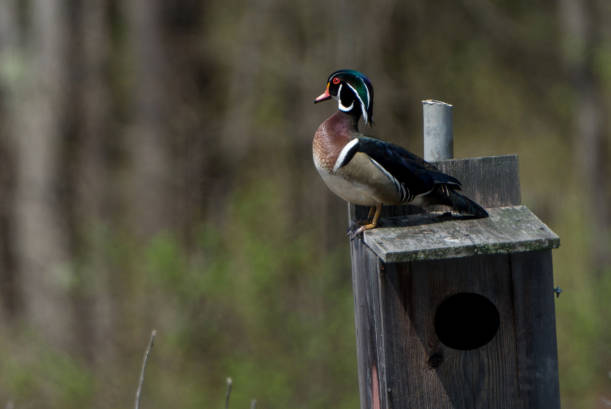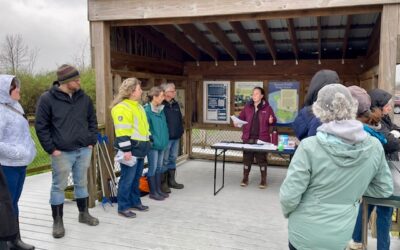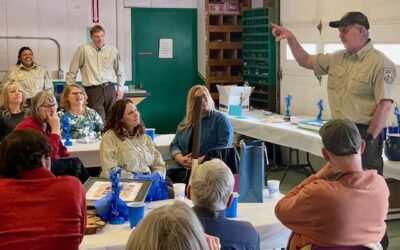
It was a gray but unusually warm February day as I followed refuge biologist Paul Hess through the winter woodlands at Iroquois National Wildlife refuge. We were headed for a row of wood duck boxes along the edge of a seasonally flooded wooded wetland. The soft natural hues of tree bark were punctuated here and there with a splash of evergreen or the copper of winter beech leaves on higher ridges of ground. In the lower areas, we squished through mud in our rubber boots and occasionally broke through a layer of crisp ice. With the coming spring melt, and enough rain throughout spring, these wet areas will thaw, spread, and deepen to create perfect wood duck breeding habitat. As we got closer to the open marsh at the edge of the forest, the honking and thundering of geese taking flight echoed through the stillness.
We arrived at a large weathered wooden nest box blending in with the surrounding trees. The box was mounted atop a tall pole, to mimic the natural tree cavities used by wood ducks and was equipped with a cone-shaped metal baffle. This fashionable pole skirt is used to keep predators at bay. Paul had been hauling a rather inconvenient ladder through the obstacles of the woods and he now climbed up to the box and removed the pins holding the door shut. The side of the box hinged open and revealed… nothing. Just a layer of wood chips provided as last year’s bedding. We marked the box as empty and moved on, alternating turns on the ladder. The first few boxes were the same, until, on my second try, I opened a box to find a small reddish screech owl squinting grumpily up at me. Unlike the wood ducks, eastern screech owls stay in western New York all year long and often use wood duck boxes as sheltered winter roosts.
A few boxes later, we finally found our feathery objective. I peered down at a vacant but used nest from last summer. The ducks had added a layer of soft down feathers to the wood chips and a few creamy white eggs about half the size of a chicken egg remained. Wood ducks typically lay between 6 and 16 eggs, but it is not uncommon, especially at sites with less tree cover, for females to sneak a few eggs into the neighbor’s nest. This can lead to especially large broods of mixed parentage, a few unhatched eggs, or in extreme cases, an abandoned nest. Paul explained how to sift through the nest for bits of the thick leathery membrane found inside a hatched egg. Discovering a piece of leftover membrane not attached to any shell indicated that last summer, a duckling had hatched without any troubles.

Wood ducks, like all waterfowl, have precocial young. This means the ducklings hatch with a full coat of downy feathers, with eyes open and the ability to immediately walk and swim. Although they would have stayed with their parents for five to six weeks, the ducklings from this box jumped to the water below within only a day of hatching. Each nest box has a piece of mesh screen inside to make the climb up to the opening easier for the young. We marked the nest as successful and continued following the water’s edge.
Today, wood ducks are relatively abundant at Iroquois and throughout central and eastern United States, but this was not always the case. During the late 19th century, overhunting and loss of habitat caused a drastic decline in wood duck populations. It is only through careful management, and conservation programs to provide appropriate habitat, that the species has rebounded. Duck boxes, preservation of wooded wetland, and management of water levels at wildlife refuges like Iroquois, has greatly contributed to species recovery.
Adult wood ducks are easily identified by their small size and beautiful plumage. Breeding males are especially showy with an extravagance of iridescent blues and violets, a green crest, chestnut breast, and bright red bill. Females also have a crest but are brownish grey with muted iridescence and a bold white eye ring. Wood ducks have short wings and unusually large eyes which allow them to see and maneuver more easily in their forested habitat. Unlike most waterfowl, wood ducks find themselves at home in the trees where their sharp nails allow them to move about easily in branches and nesting cavities.
Waterfowl can be split into two main groups by their eating habits. Diving ducks use strong legs set far back on the body to propel themselves entirely under water. Dabblers, like wood ducks, have more centrally located legs and stay on or close to the surface, dipping their heads under to feed. Wood ducks forage for plants, seeds, insects, and small invertebrates in shallow water. They tend to be shy and stay apart from other waterfowl, but if you are careful and quiet you can often see small groups of wood ducks on marsh edges or in flooded forest throughout Iroquois.
My day ended with the discovery of many successful nests and a whole string of newly cleaned duck condos waiting for this year’s tenants. In the late afternoon, a few rays of sun finally broke through the winter gloom. In only a few weeks the wood ducks will be back!
by Emma DeLeon





